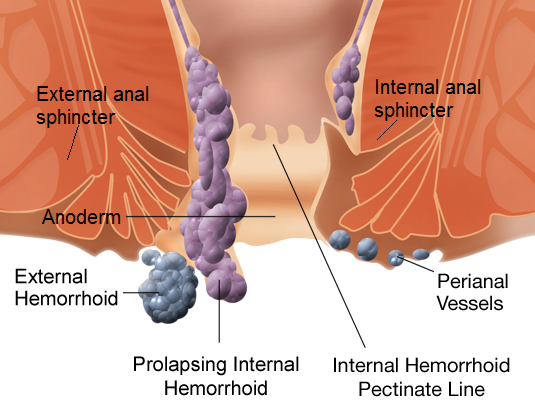So what are Hemorrhoids?
Hemorrhoids are very common, especially during pregnancy and after childbirth. They result from increased pressure in the veins of the anus. The pressure causes the veins to bulge and expand, making them painful, particularly when you are sitting.
The most common cause is straining during bowel movements. Hemorrhoids may result from constipation, sitting for long periods of time and anal infections. In some cases they may be caused by other diseases, such as liver cirrhosis.
> Read More about Hemorrhoid treatment & Symptoms
Internal hemorrhoids occur just inside the anus at the beginning of the rectum. External hemorrhoids occur at the anal opening and may protrude outside the anus. Symptoms of hemorrhoids include anal itching, anal pain, bright red blood on toilet tissue, pain during bowel movements or a hard tender lump near the anus.
Hemorrhoids can be diagnosed by rectal examination and anoscopy (lighted tube inserted into the anus) but there are three main treatment options. You can learn more below.
Hemorrhoid Treatment in Tampa
HEMORRHOIDECTOMY
A hemorrhoidectomy is an operation to remove hemorrhoidal tissue. It is used to treat painful, swollen hemorrhoids when they do not get better with other therapies. Severe bleeding, severe pain, thrombosed hemorrhoids and prolapsed hemorrhoids are some indications for surgery.
HEMORRHOID BANDING
Hemorrhoid banding is performed in our office with local anesthesia, but it is a very basic procedure.
It's recommended that only 1 to 2 hemorrhoids be removed per procedure. While some people prefer to have all of them banded at one time, it should be noted that this usually causes extreme pain and it's better to treat a couple hemorrhoids at a time every 4 to 6 weeks.
What You Can Expect:
- Some bleeding for up to 14 days after the procedure
- Difficulty controlling flatulation and bowel movements
- Sitz baths can help relieve discomfort and clean the area
- Constipation is common but using a stool softener, drinking fluids and eating high fiber foods can help
NEW THD SYSTEM
This new minimally invasive technique, Transanal Hemorrhoidal Dearterialization (THD), uses a Doppler ultrasound probe to pinpoint the actual branches of the hemorrhoidal arteries.
An absorbable suture is then used to “tie-off” or ligate the arterial blood flow. This technique does not remove any tissue, instead a “lift” is actually performed which is called a Hemorrhoidopexy. This restores the protruding tissue back to its correct anatomical position. Because there is no tissue being removed, the post-operative pain is significantly reduced and the recovery and return to daily activities is much quicker.
The procedure only takes about 30 minutes and most people are able to return to work or normal activity in as few as 3 to 4 days.


